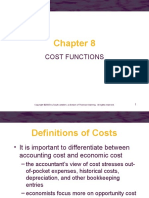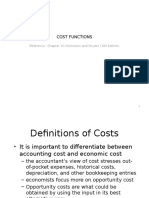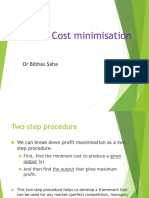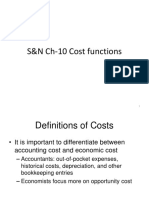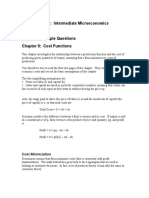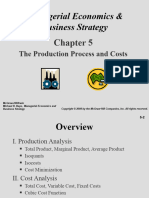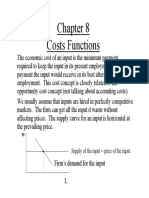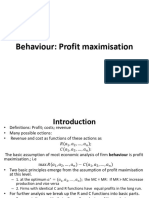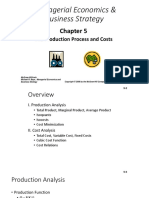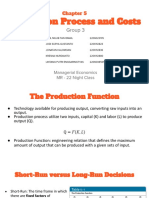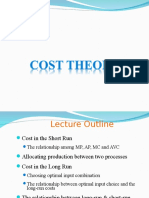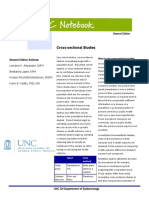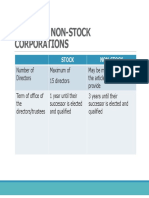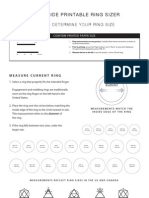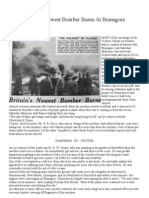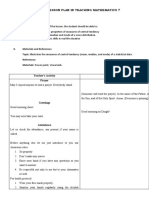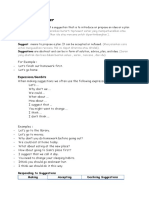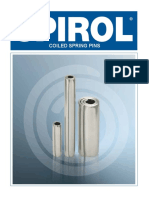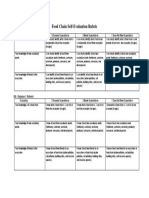Cost Functions
[See Chap
10]
. 1
Definitions of Costs
• Economic costs include both
implicit and explicit costs.
• Explicit costs include wages
paid to employees and the
costs of raw materials.
• Implicit costs include the
opportunity cost of the
entrepreneur and the capital
used for production.
2
Economic Cost
• The economic cost of any input
is its opportunity cost:
– the remuneration the input would
receive in its best alternative
employment
1
� Model
• Firm produces single output, q
• Firm has N inputs {z1,…zN}.
• Production function q = f(z1,…zN)
– Monotone and quasi-concave.
• Prices of inputs {r1,…rN}.
• Price of output p.
Firm’s Payoffs
• Total costs for the firm are given by
total costs = C = r1z1 + r2z2
• Total revenue for the firm is given by
total revenue = pq = pf(z1,z2)
• Economic profits () are equal
to
= total revenue - total cost
= pq - r1z1 - r2z2
pf(z1,z2) - r1z1 - r2z2
=
5
Firm’s Problem
• We suppose the firm maximizes profits.
• One-step solution
– Choose (q,z1,z2) to maximize
• Two-step solution
– Minimize costs for given output level.
– Choose output to maximize revenue minus costs.
• We first analyze two-step method
– Where do cost functions come from?
2
� COST MINIMIZATION PROBLEM
. 7
Cost-Minimization Problem (CMP)
• The cost minimization problem is
min r1 z1 r2 z2 s.t. f (z1 , z2 ) q and z1 , z2 0
• Denote the optimal demands by zi*(r1,r2,q)
• Denote cost function by
C(r1,r2,q) = r1z1*(r1,r2,q) + r2z2*(r1,r2,q)
• Problem very similar to EMP.
• Output constraint binds if f(.) is monotone.
CMP: Graphical Solution
Given output q, we wish to find the lowest
cost point on the isoquant
z2
Isocost line are parallel
C1 with
slopeaof –
C3 r1/r2:
C2
C1 < C2 <
Z1 C 3 9
3
� CMP: Graphical Solution
The minimum cost of producing q is C2
z2 This occurs at the
tangency between the
C1
C3
isoquant and the total
cost curve
C2
z2* The optimal
q
choice
is (z1*,z2*)
z1* z1 10
CMP: Lagrangian Method
• Set up the Lagrangian:
L = r1z1 + r2z1 + [q - f(z1,z2)]
• Find the first order conditions:
L/z1 = r1 - (f/z1) = 0
L/z2 = r2 - (f/z2) = 0
L/ = q - f(z1,z2) = 0
11
Cost-Minimizing Input Choices
• Dividing the first two conditions we get:
r1 f / z
r f 1/ z
2
MRTS 2
• The cost-minimizing firm equates the MRTS
for the two inputs to the ratio of their prices.
• Equivalently, the firm equates the
bang-per- buck from each input
f / z1 f / z2
r
r1 2
12
4
� Interpretation of Multiplier
• Note that the first order conditions
imply the following:
r1 r
2
f1 f2
• The Lagrange multiplier describes
how much total costs would
increase if output q would
increase by a small amount.
13
The Firm’s Expansion Path
• The firm can determine the cost-
minimizing combinations of z1 and
z2 for every level of output
• The set of combinations of
optimal amount of z1 and z2 is
called the firm’s expansion path.
14
The Firm’s Expansion Path
The expansion path is the locus of cost-
minimizing tangencies
Z2 The curve shows
how inputs
E
increase as
output increases
q2
q1
q0
Z1 15
5
� The Firm’s Expansion Path
• The expansion path does not have
to be a straight line
– the use of some inputs may increase
faster than others as output expands
– depends on the shape of the isoquants
• The expansion path does not have
to be upward sloping.
16
Example: Symmetric CD
• Production function is symmetric
cobb- douglas:
q= z z
1 2
• The Lagrangian for the CMP is
L = r1z1 + r2z2 + [q - z1z2]
17
Example: Symmetric CD
• FOCs for a minimum:
L/z1 = r1 - z1(-1)z2 = 0
L/z2 = r2 - z1z2(-1) = 0
• Rearranging yields r1z1=r2z2.
• Using the constraint q=z1z2,
1/ 2 1/ 2
z1* (r1 , r2 , q) r2 q1/ 2 and z 2* (r1 , r2 , q) r1 1/ 2
q r1 r2
• Substituting, the
cost is c(r , r , q) r z* r z* 2(r r )1/ 2
1 2 1 1 2 2 1 2
q1/ 2 18
6
�Example: Perfect Complements
• Suppose
q = f(z1, z2) = min(z1,z2)
• Production will occur at the vertex
of the L-shaped isoquants, z1 = z2.
• Using constraint, z1 = z2 = q
• Hence cost function is
C(r1,r2,q) = r1z1 + r2z2 = (r1+r2)q
19
COST FUNCTIONS
. 20
Total Cost Function
• The cost function shows the
minimum cost incurred by the
firm is
C(r1,r2,q) = r1z1*(r1,r2,q) + r2z2*(r1,r2,q)
• Cost is a function of output and
input prices.
• When prices fixed, sometimes write
C(q)
7
� Average Cost Function
• The average cost function (AC) is
found by computing total costs
per unit of output
average C(r1, r2 ,
cost AC(r1 , 2r , q)
q) q
22
Marginal Cost Function
• The marginal cost function (MC)
equals the extra cost from one
extra unit of output.
C(r , r ,
marginal cost MC(r1 , 2r , q) q) 1 2
q
23
Picture #1
• Concave production function.
24
8
� Picture #2
• Non-concave production function
25
Picture #3
• Non-concave production function.
• Fixed cost of production.
26
Cost Function: Properties
1. c(r1,r2,q) is homogenous of degree 1 in
(r1,r2)
– If prices double constraint unchanged, so
cost doubles.
2. c(r1,r2,q) is increasing in (r1,r2,q)
3. Shepard’s Lemma:
i
c(r1, r 2, q) z* (r1, r 2, q)
– If r1 rises by ∆r, then c(.) rises by ∆r×z*1(.)
– Input demand also changes, but effect second
order.
4. c(r1,r2,q) is concave in 27
(r1,r2)
9
� Cost Function: Concavity and
Shepard’s Lemma
At r*1, the cost is c(r*1,
…)=r*1z*1+ r*2z*2
If the firm continues to
buy the same input mix
c(r1,…) cpseudo as r1 changes, its cost
function would be
c(r1,…)
Cpseudo
c(r*1,…)
Since the firm’s input
mix
will likely change,
actual costs will be
less than Cpseudo such
r*1
r1 28
Cost Function: Properties
5. If f(z1,z2) is concave then c(r1,r2,q) is
convex in q. Hence MC(q) increases in q.
– Concavity implies decreasing returns.
– More inputs needed for each unit of q, raising
cost.
6. If f(z1,z2) is exhibits decreasing
(increasing) returns then AC(q) increases
(decreases) in q.
– Under DRS, doubling inputs produces
less than double output. Hence average
cost rises.
7. AC(q) is increasing when MC(q)≥AC(q), 29
– When AC(q) minimized,
MC(q)=AC(q).
Average and Marginal Costs
Average
and MC is the slope of the C
margin curve
al If AC >
costs
AC
MC,
AC must
be falling
If AC <
MC,
min
AC AC must
be rising
30
10
� Can Costs Look Like This?
• Left: When AC minimized, MC=AC.
• Right: If no fixed costs AC=MC for first unit.
If fixed costs, AC=∞ for first unit.
31
Input Demand: Properties
1. z*i(r1,r2,q) is homogenous of degree 0 in
(r1,r2)
– If prices double constraint unchanged, so
demand unchanged.
*
z r 2 r1c r1 r2 c 2
r2 r1
1 *
z
– Uses Shepard’s
Lemma
3. Law of *
demand z c
r1 1 r1 r1 0
– Uses Shepard’s Lemma and concavity
of c(.) 32
SHORT-RUN VS. LONG-RUN
. 33
11
� Short-Run, Long-Run
Distinction
• Costs may differ in the short and long run.
• In the short run it is (relatively) easy to
hire and fire workers but relatively
difficult to change the level of the capital
stock.
• Suppose firm wishes to raise production
– Can’t change capital stock
– Hires more workers.
– Capital/Labor balance no longer optimal.
– High production costs.
34
Time Frames
• In very short run, all inputs are fixed.
• In short run, some inputs fixed with
others are flexible.
• In medium run, all inputs are flexible
but firm cannot enter/exit.
– Fixed costs are sunk.
• In long run, all factor are flexible and
firm can exit without cost.
35
Example: f(z1,z2)=(z1-1)1/3(z2-1)1/3
• Cobb-Douglas production but first
unit of each input is useless.
• In long run,
L = r1z1 + r2z2 + [q - (z1-1)1/3(z2-1)1/3]
• FOC becomes r1(z1-1)=r2(z2-1).
• Using constraint, demands are
1/ 2 1/ 2
z1* (r1 , r2 , q) r 2 q3/ 2 1 z*2 (r1 , r2 , q) r 1 q3/ 2
and r1 1 r2
• Long-run cost
function
c(r1 , r2 , q) 1r 1*z 2 r 2*2z 2(r 1/ 2
1 2 r )
1/
q (r1 r2 )
with c(r1,r2,0)=0. 36
12
�Example: f(z1,z2)=(z1-1)1/3(z2-1)1/3
• In medium run, startup cost of (r1+r2) is
sunk.
• Cost c(r
function is
* thus* 1/ 2 1/
1 , r2 , q) 1r 1z 2 r 2z 2(r
1 2 r
2) q (r1 r2 )
with c(r1,r2,0) =
r1+r2.
37
Example: f(z1,z2)=(z1-1)1/3(z2-1)1/3
• In short run, z2 is fixed at z2’.
• The constraint in the CMP becomes
q = (z1-1)1/3(z2’-1)1/3
• Rearranging, 3
z1* q 1
z2 '1
• Cost function
is c(r , r , q) r z* r z '
3
rq r r z '
1 2 1 1 2 2 1
z2 '1 1 2 2
• In very short run, (z1,z2) fixed so output
fixed.
Short-Run Total Costs
z2
When z2 is fixed at z2’,
the firm cannot equate
MRTS with the ratio of
input prices
z2’
q2
q1
q0
z1' Z1 “ Z1’’’
z1
39
13
� Relationship between Short-
Run and Long-Run Costs
SC (z2’’)
Total SC (z2’)
costs C
SC (z2)
The long-
run
C curve can
be derived
by varying
the level of
z2
q q’ q’’ 40
Short-Run Marginal and
Average Costs
• The short-run average total cost
(SAC) function is
SAC = total costs/total output = SC/q
• The short-run marginal cost (SMC)
function is
SMC = change in SC/change in output =
SC/q
41
14



